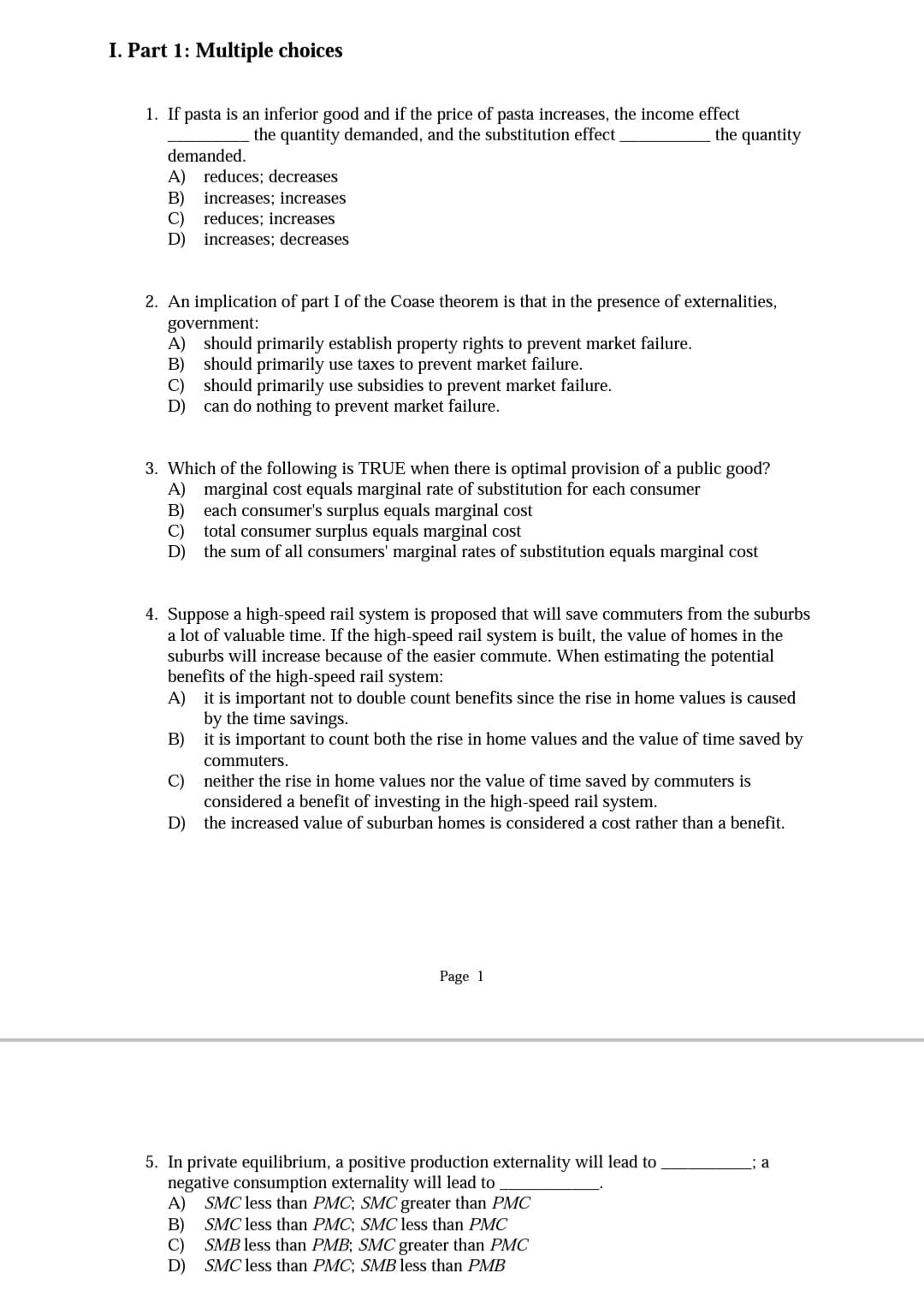1. If pasta is an inferior good and if the price of pasta increases, the income effect the quantity demanded, and the substitution effect the quantity demanded. A) reduces; decreases B) increases; increases C) reduces; increases D) increases; decreases
1. If pasta is an inferior good and if the price of pasta increases, the income effect the quantity demanded, and the substitution effect the quantity demanded. A) reduces; decreases B) increases; increases C) reduces; increases D) increases; decreases
Chapter13: General Equilibrium And Welfare
Section: Chapter Questions
Problem 13.13P
Related questions
Question

Transcribed Image Text:I. Part 1: Multiple choices
1. If pasta is an inferior good and if the price of pasta increases, the income effect
the quantity demanded, and the substitution effect
the quantity
demanded.
A) reduces; decreases
В)
increases; increases
C)
reduces; increases
D) increases; decreases
2. An implication of part I of the Coase theorem is that in the presence of externalities,
government:
A) should primarily establish property rights to prevent market failure.
B) should primarily use taxes to prevent market failure.
C)
should primarily use subsidies to prevent market failure.
D)
can do nothing to prevent market failure.
3. Which of the following is TRUE when there is optimal provision of a public good?
A) marginal cost equals marginal rate of substitution for each consumer
B)
each consumer's surplus equals marginal cost
C)
total consumer surplus equals marginal cost
D) the sum of all consumers' marginal rates of substitution equals marginal cost
4. Suppose a high-speed rail system is proposed that will save commuters from the suburbs
a lot of valuable time. If the high-speed rail system is built, the value of homes in the
suburbs will increase because of the easier commute. When estimating the potential
benefits of the high-speed rail system:
A) it is important not to double count benefits since the rise in home values is caused
by the time savings.
it is important to count both the rise in home values and the value of time saved by
В)
commuters.
C)
neither the rise in home values nor the value of time saved by commuters is
considered a benefit of investing in the high-speed rail system.
D) the increased value of suburban homes is considered a cost rather than a benefit.
Page 1
5. In private equilibrium, a positive production externality will lead to
negative consumption externality will lead to
A) SMC less than PMC; SMC greater than PMC
SMC less than PMC; SMC less than PMC
: a
B)
SMB less than PMB; SMC greater than PMC
C)
D) SMC less than PMC; SMB less than PMB
Expert Solution
This question has been solved!
Explore an expertly crafted, step-by-step solution for a thorough understanding of key concepts.
This is a popular solution!
Trending now
This is a popular solution!
Step by step
Solved in 2 steps

Recommended textbooks for you


Principles of Microeconomics
Economics
ISBN:
9781305156050
Author:
N. Gregory Mankiw
Publisher:
Cengage Learning

Principles of Economics, 7th Edition (MindTap Cou…
Economics
ISBN:
9781285165875
Author:
N. Gregory Mankiw
Publisher:
Cengage Learning


Principles of Microeconomics
Economics
ISBN:
9781305156050
Author:
N. Gregory Mankiw
Publisher:
Cengage Learning

Principles of Economics, 7th Edition (MindTap Cou…
Economics
ISBN:
9781285165875
Author:
N. Gregory Mankiw
Publisher:
Cengage Learning

Principles of Economics (MindTap Course List)
Economics
ISBN:
9781305585126
Author:
N. Gregory Mankiw
Publisher:
Cengage Learning

Principles of Microeconomics (MindTap Course List)
Economics
ISBN:
9781305971493
Author:
N. Gregory Mankiw
Publisher:
Cengage Learning